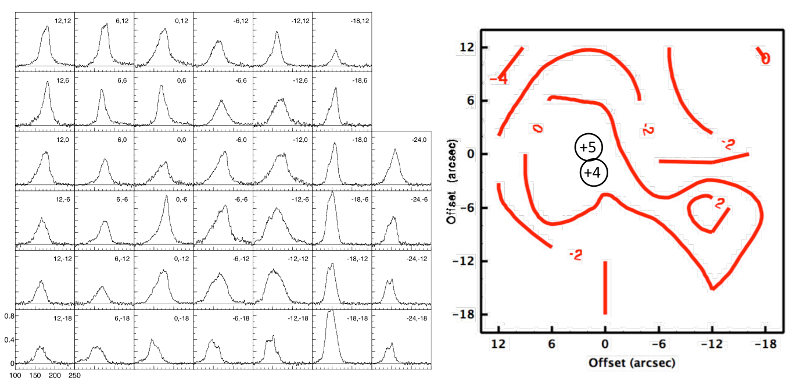| EPoS Contribution |
|
The Next Major Step in Zeeman Studies of Magnetic Fields in Star Formation Regions
Richard Crutcher U Illinois, Urbana, IL, US | |
| The precise role of magnetic fields in star formation remains unclear. Zeeman observations are crucial since they are the only available technique for directly measuring magnetic field strengths. In this talk I will discuss the first example of the next major advance in Zeeman studies of the role of magnetic fields in the star formation process - that is, fully spatially sampled high-resolution maps of magnetic field strengths that probe high gas density. This first case is the W3OH region of high-mass star formation. W3OH has an UCHII region, a very high-density molecular core (Turner-Welch object), and an extended region of high-density gas, so magnetic fields over a range of density and evolutionary state may be examined. Our fully spatially sampled map, which will be produced by combining our IRAM 30-m single-dish Zeeman mapping with our CARMA interferometer Zeeman observations, will have a spatial resolution of about 4". These maps are made with the 226 GHz N=2-1 transition of CN, which has a critical excitation density of about 2 x 106 per cc. The figure of CN line intensity profiles (below) shows the tremendous spatial and kinematic structure present toward W3OH, and emphasizes the necessity of high angular resolution observations. The figure also shows a preliminary version of the IRAM single-dish map of the magnetic field strength B with two CN intensity and magnetic field "hot spots" from our CARMA mapping superposed. Making the combined map with these IRAM and CARMA data that are in hand is underway now. Using this map, I will examine the relationship of the magnetic field to the spatial structure in the mass and the kinematics, the variation of the mass to magnetic flux ratio with mass and evolutionary state, and the scaling of B with density by comparing B inferred from our CN N=2-1 and published N=1-0 transitions (which have a ratio of critical densities of about 8). With these results I will discuss the astrophysical implications for the role of magnetic fields in star formation. Finally, I will explore the implications of this type of Zeeman mapping of magnetic field strengths for future studies with ALMA, and how questions about the precise role of magnetic fields in star formation may be answered. | |
 | |
| Caption: W3OH CN N=2-1 Zeeman results. LEFT: CN line intensity profiles from IRAM 30-m telescope mapping (antenna temperature vs. channel number, channel spacing = 0.04 km/s). RIGHT: Preliminary line-of-sight B(mG) map. Red contours are from IRAM 30-m telescope mapping of the CN N=2-1 226 GHz transitions with 11" resolution; all observed positions shown at left have yet to be Zeeman fitted and included, so this is only the preliminary single-dish map of B(los). Black circles show the beam sizes and positions of two positions with CARMA interferometer CN Zeeman detections with 4" resolution; numbers within circles are line-of-sight B(mG). The (0,0) position is RA(2000) = 02:27:05.5, Dec(2000) = 61:52:32. These single-dish and interferometer CN Zeeman maps are being combined to make the 4" resolution maps of B(los) that will be presented and discussed at the meeting. | |
| Collaborators: E. Falgarone, ENS, FR N. Hakobian, UIUC, US P. Hily-Blant, UJF, FR C. Hull, CfA, US L. Looney, UIUC, US M. Lopez, IAR, AR R. Playback, UCB, US I. Stephens, BU, US T. Troland, UK, US |
Suggested Session:
Magnetic Fields |

